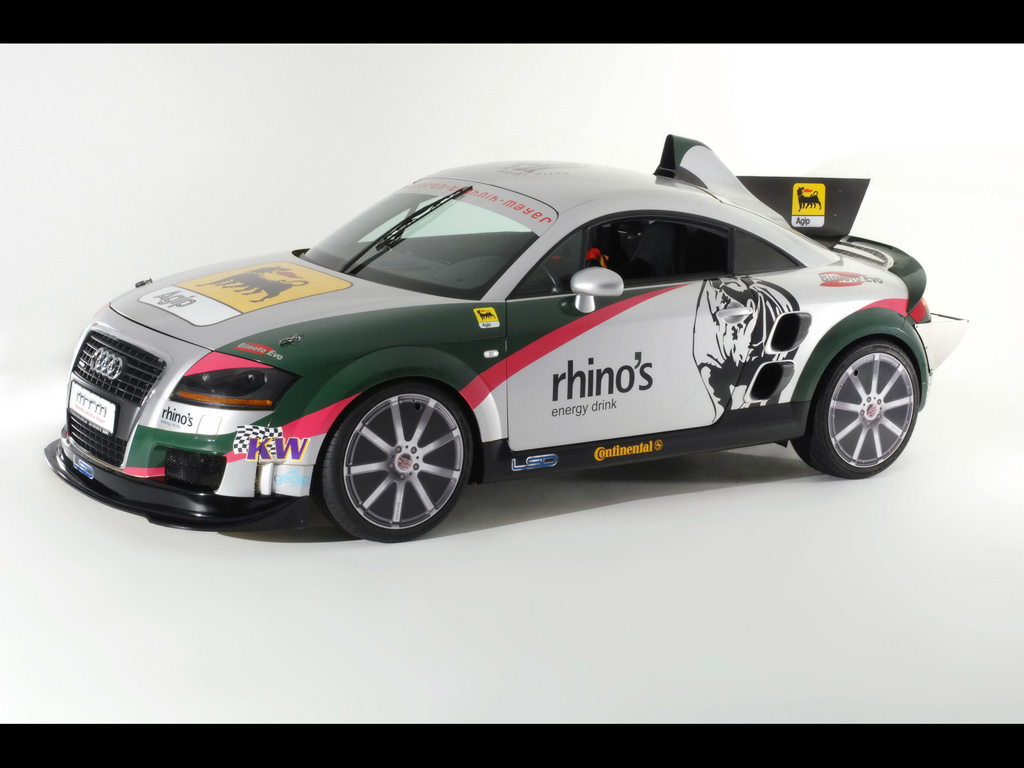2007 mtm Audi TT bimoto
|
Price |
-- |
Production |
-- | ||
|
Engine |
(2) 1.8 liter inline-4s |
Weight |
3285 lbs | ||
|
Aspiration |
turbocharged |
Torque |
-- | ||
|
HP |
740 hp total |
HP/Weight |
4.4 lbs per hp | ||
|
HP/Liter |
205.6 hp per liter |
1/4 mile |
-- | ||
|
0-62 mph |
3.1 seconds |
Top Speed |
244 mph |
(from MTM Press Release) The mtm Bimoto, probably the most impressive vehicle produced by mtm, is based on the Audi TT and is equiped with two four cylinder turbo-engine. Even the starting performance makes overwhelming driving powers possible. Because of further engine-modifications together is a maximum 1000 HP possible.
The story:
The latest project - the
mtm bimoto - is one of the exclusive and extraordinary special
vehicles of mtm. Once more it shows that the founder Roland Mayer
wants more engine power and perfection.
Mercedes made a similar study (two engines in a A 190) with 15
employees in 4 months which means 60 work-hours in a month. mtm
developed the TT bimoto in only 50 work-hours.
The idea of two engines sounds strange at first, but it has lots of
advantages compared with other ideas. To construct a V-8 turboengine
for example we would have had to choose a central engine
arrangement, which would have required the development of a special
and more expensive allroad transmission.
For the drive of his two axles the mtm bimoto has two engines and
two transmissions. Below the slightly changed body of the Audi TT
hides more than expected at first sight. Both in front and rear
every transmission is driven by its own 1.8 l four cylinder
turbo-engine. A partition made of carbon including a rear window
separates the maximum two passengers from the second drive unit in
the rear. What you can find in it is that almost every aggregate is
double of the front one. Likewise there is a manual six gear
transmission installed on the opposite of the driven direction which
is driven by a 1.8 l cylinder in almost he same axis of the front
part. To make power shifts possible double-clutches-transmissions
will be obstructed in the new future. A welded cage stabilizes the
complete car and includes the both aggregates.
The engines in the rear and in front move independently. The power
comes from the street which is the connecting part between the two
engines. Loading air, oil and water cooler, clutch and a second
petrol pump, everything exits twice. Air not needed is lead back to
the aerodynamic formed parts below the body and should especially at
high speed improve the drive at the rear and it is supported by a
diffusor. A marked carbon lip at the mtm tail wing supports this
effect, too.
By the standard rear window, similar to a Ferrari 360 Modena, it is
possible, even desired, to look at the technology of the second
drive unit. According to Roland Mayer the plastic covers only use is
not to have to tidy up electronic cables and lines. This expenditure
is operated by mtm because the customer should be able to look at
the technology of the bimoto.
The customer will feel
the technology, that's already sure. The project double enginge
vehicle is remarkable but for a firm with the entitlement of mtm not
sufficient. Both engines will be far away concerning the performance
output compared to the series. Unwaveringly and also everyday
life-suited 740 HP, thus 370 HP for each engine, are the minimum.
Even 501 HP per four-cylinder are possible, which will be reached by
a capacity enlargement to 2 litres, big turboloaders and working on
the periphery, says Mayer full of proud. Finally however the
customer should have the choice to decide on performance variant
respectively deployment purpose of the vehicle.
The target is to give the car a handling, which is any time
calculable. It may not surprise the driver with a change between
under- and overriding but has to show the tendency to override. In
Wettstetten we use therefore the standard sensors for the ABS
system. The monitoring of the number of revolutions at all four
wheels allows, by the help of the engine-electronic, an exact
invasion to the handling of the bimoto. For expample with slip at
the front axle performance will be taken back from the front
four-cylinder to avoid underriding. Similarly to that traction
problems and power influences of the driven front axle to the
steering will be avoided.
Behind the front, forged 19''-light metal rim a Brembo braking
system is installed. Ventilated disc brakes, 32 millimeters strong
and 355 millimeters in the diameter are taken there by a four-piston
caliper into the pliers. At the rear axle acceleration will be
converted to delay with ventilated, 330 millimeters big brake discs
and a four-piston caliper.
With six-point-belts in Recaro full-bucket seats in future maximally
two passengers have the possibility to feel the experience double
engine in the exclusive MTM bimoto.
The development costs for the prototype are about 600.000 euro. A
small series of 10 vehicles is planned. Optionally also a
race-suspension and/or race-suspension-parts can be ordered.



